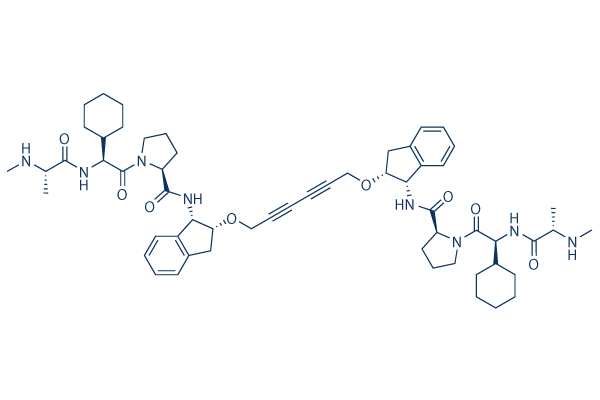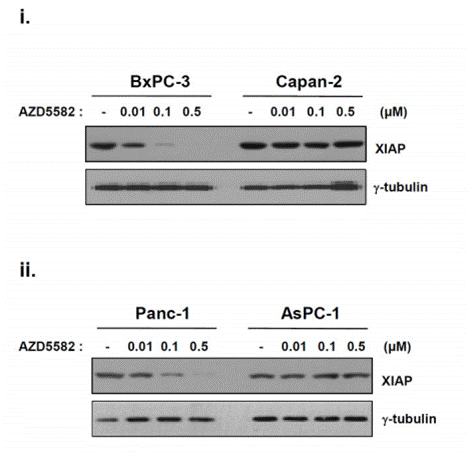
- Inhibitors
- By product type
- Natural Products
- Inducing Agents
- Peptides
- Antibiotics
- Antibody-drug Conjugates(ADC)
- PROTAC
- Hydrotropic Agents
- Dyes
- By Signaling Pathways
- PI3K/Akt/mTOR
- Epigenetics
- Methylation
- Immunology & Inflammation
- Protein Tyrosine Kinase
- Angiogenesis
- Apoptosis
- Autophagy
By research - Antibodies
- Compound Libraries
- Popular Compound Libraries
- Customize Library
- Clinical and FDA-approved Related
- Bioactive Compound Libraries
- Inhibitor Related
- Natural Product Related
- Metabolism Related
- Cell Death Related
- By Signaling Pathway
- By Disease
- Anti-infection and Antiviral Related
- Neuronal and Immunology Related
- Fragment and Covalent Related
- FDA-approved Drug Library
- FDA-approved & Passed Phase I Drug Library
- Preclinical/Clinical Compound Library
- Bioactive Compound Library-I
- Bioactive Compound Library-Ⅱ
- Kinase Inhibitor Library
- Express-Pick Library
- Natural Product Library
- Human Endogenous Metabolite Compound Library
- Alkaloid Compound LibraryNew
- Angiogenesis Related compound Library
- Anti-Aging Compound Library
- Anti-alzheimer Disease Compound Library
- Antibiotics compound Library
- Anti-cancer Compound Library
- Anti-cancer Compound Library-Ⅱ
- Anti-cancer Metabolism Compound Library
- Anti-Cardiovascular Disease Compound Library
- Anti-diabetic Compound Library
- Anti-infection Compound Library
- Antioxidant Compound Library
- Anti-parasitic Compound Library
- Antiviral Compound Library
- Apoptosis Compound Library
- Autophagy Compound Library
- Calcium Channel Blocker LibraryNew
- Cambridge Cancer Compound Library
- Carbohydrate Metabolism Compound LibraryNew
- Cell Cycle compound library
- CNS-Penetrant Compound Library
- Covalent Inhibitor Library
- Cytokine Inhibitor LibraryNew
- Cytoskeletal Signaling Pathway Compound Library
- DNA Damage/DNA Repair compound Library
- Drug-like Compound Library
- Endoplasmic Reticulum Stress Compound Library
- Epigenetics Compound Library
- Exosome Secretion Related Compound LibraryNew
- FDA-approved Anticancer Drug LibraryNew
- Ferroptosis Compound Library
- Flavonoid Compound Library
- Fragment Library
- Glutamine Metabolism Compound Library
- Glycolysis Compound Library
- GPCR Compound Library
- Gut Microbial Metabolite Library
- HIF-1 Signaling Pathway Compound Library
- Highly Selective Inhibitor Library
- Histone modification compound library
- HTS Library for Drug Discovery
- Human Hormone Related Compound LibraryNew
- Human Transcription Factor Compound LibraryNew
- Immunology/Inflammation Compound Library
- Inhibitor Library
- Ion Channel Ligand Library
- JAK/STAT compound library
- Lipid Metabolism Compound LibraryNew
- Macrocyclic Compound Library
- MAPK Inhibitor Library
- Medicine Food Homology Compound Library
- Metabolism Compound Library
- Methylation Compound Library
- Mouse Metabolite Compound LibraryNew
- Natural Organic Compound Library
- Neuronal Signaling Compound Library
- NF-κB Signaling Compound Library
- Nucleoside Analogue Library
- Obesity Compound Library
- Oxidative Stress Compound LibraryNew
- Plant Extract Library
- Phenotypic Screening Library
- PI3K/Akt Inhibitor Library
- Protease Inhibitor Library
- Protein-protein Interaction Inhibitor Library
- Pyroptosis Compound Library
- Small Molecule Immuno-Oncology Compound Library
- Mitochondria-Targeted Compound LibraryNew
- Stem Cell Differentiation Compound LibraryNew
- Stem Cell Signaling Compound Library
- Natural Phenol Compound LibraryNew
- Natural Terpenoid Compound LibraryNew
- TGF-beta/Smad compound library
- Traditional Chinese Medicine Library
- Tyrosine Kinase Inhibitor Library
- Ubiquitination Compound Library
-
Cherry Picking
You can personalize your library with chemicals from within Selleck's inventory. Build the right library for your research endeavors by choosing from compounds in all of our available libraries.
Please contact us at info@selleckchem.com to customize your library.
You could select:
- Bioreagents
- qPCR
- 2x SYBR Green qPCR Master Mix
- 2x SYBR Green qPCR Master Mix(Low ROX)
- 2x SYBR Green qPCR Master Mix(High ROX)
- Protein Assay
- Protein A/G Magnetic Beads for IP
- Anti-Flag magnetic beads
- Anti-Flag Affinity Gel
- Anti-Myc magnetic beads
- Anti-HA magnetic beads
- Poly DYKDDDDK Tag Peptide lyophilized powder
- Protease Inhibitor Cocktail
- Protease Inhibitor Cocktail (EDTA-Free, 100X in DMSO)
- Phosphatase Inhibitor Cocktail (2 Tubes, 100X)
- Cell Biology
- Cell Counting Kit-8 (CCK-8)
- Animal Experiment
- Mouse Direct PCR Kit (For Genotyping)
- Featured Products
- MRTX1133
- Nab-Paclitaxel
- KP-457
- IAG933
- RMC-6236 (Daraxonrasib)
- RMC-7977
- Zoldonrasib (RMC-9805)
- GsMTx4
- Navitoclax (ABT-263)
- TSA (Trichostatin A)
- Y-27632 Dihydrochloride
- SB431542
- SB202190
- MK-2206 Dihydrochloride
- LY294002
- Alisertib (MLN8237)
- XAV-939
- CHIR-99021 (Laduviglusib)
- Bafilomycin A1 (Baf-A1)
- Thiazovivin (TZV)
- CP-673451
- Verteporfin
- DAPT
- Galunisertib (LY2157299)
- MG132
- SBE-β-CD
- Tween 80
- Bavdegalutamide (ARV-110)
- Z-VAD-FMK
- Wnt-C59 (C59)
- IWR-1-endo
- (+)-JQ1
- 3-Deazaneplanocin A (DZNep) Hydrochloride
- RepSox (E-616452)
- Erastin
- Q-VD-Oph
- Puromycin Dihydrochloride
- Cycloheximide
- Telaglenastat (CB-839)
- A-83-01
- Ceralasertib (AZD6738)
- Liproxstatin-1
- Emricasan (IDN-6556)
- PMA (Phorbol 12-myristate 13-acetate)
- Dibutyryl cAMP (Bucladesine) sodium
- Nedisertib (M3814)
- PLX5622
- IKE (Imidazole Ketone Erastin)
- STM2457
- Saruparib (AZD5305)
- New Products
- Contact Us
research use only
AZD5582 IAP inhibitor
Cat.No.S7362

Chemical Structure
Molecular Weight: 1015.29
Quality Control
Batch:
Purity:
99.08%
99.08
Cell Culture, Treatment & Working Concentration
| Cell Lines | Assay Type | Concentration | Incubation Time | Formulation | Activity Description | PMID |
|---|---|---|---|---|---|---|
| MDA-MB-231 | Antiproliferative assay | 48 hrs | Antiproliferative activity against human MDA-MB-231 cells assessed as growth inhibition after 48 hrs by Alamar Blue assay, GI50 = 0.00006 μM. | 24320998 | ||
| MDA-MB-231 | Function assay | 1 hr | Binding affinity to cIAP1 in human MDA-MB-231 cells assessed as induction of protein degradation after 1 hr by ELISA, EC50 = 0.0001 μM. | 24320998 | ||
| MDA-MB-231 | Apoptosis assay | 0.5 to 1.5 nM | 1 to 3 hrs | Induction of apoptosis in human MDA-MB-231 cells assessed as caspase-3 cleavage at 0.5 to 1.5 nM preincubated for 1 to 3 hrs followed by compound-washout measured after 24 hrs by luciferase reporter gene assay | 24320998 | |
| MDA-MB-231 | Antitumor assay | 0.1 to 3 mg/kg | 2 weeks | Antitumor activity against human MDA-MB-231 cells xenografted in CB17 SCID mouse assessed as tumor growth inhibition at 0.1 to 3 mg/kg, iv administered once a week for 2 weeks measured twice a week for 78 days | 24320998 | |
| MDA-MB-231 | Function assay | 0.05 to 3 mg/kg | 4 to 18 hrs | Induction of caspase-3 cleavage in tumor of CB17 SCID mouse xenografted with human MDA-MB-231 cells at 0.05 to 3 mg/kg, iv after 4 to 18 hrs by ELISA | 24320998 | |
| MDA-MB-231 | Function assay | 0.05 to 3 mg/kg | up to 18 hrs | Induction of cIAP1 degradation in tumor of CB17 SCID mouse xenografted with human MDA-MB-231 cells at 0.05 to 3 mg/kg, iv up to 18 hrs by ELISA | 24320998 | |
| BT549 | Growth inhibition assay | Growth inhibition of human BT549 cells | 24320998 | |||
| MDA-MB-231 | Apoptosis assay | 0.5 to 1.5 nM | 1 to 3 hrs | Induction of apoptosis in human MDA-MB-231 cells assessed as cell death at 0.5 to 1.5 nM preincubated for 1 to 3 hrs followed by compound-washout measured after 72 hrs by MTS assay | 24320998 | |
| MDA-MB-231 | Function assay | 1 uM | 4 hrs | Inhibition of XIAP-caspase-9 interaction in human MDA-MB-231 cells at 1 uM after 4 hrs by immunoprecipitation assay | 24320998 | |
| MDA-MB-231 | Function assay | 0.03 to 1 nM | 1 hr | Binding affinity to cIAP2 in human MDA-MB-231 cells assessed as induction of protein degradation at 0.03 to 1 nM after 1 hr by Western blotting analysis | 24320998 | |
| 647V | Growth inhibition assay | Growth inhibition of human 647V cells | 24320998 | |||
| 35612 | Growth inhibition assay | Growth inhibition of human 97-7 cells | 24320998 | |||
| MIAPaCa2 | Growth inhibition assay | Growth inhibition of human MIAPaCa2 cells | 24320998 | |||
| Click to View More Cell Line Experimental Data | ||||||
Chemical Information, Storage & Stability
| Molecular Weight | 1015.29 | Formula | C58H78N8O8 |
Storage (From the date of receipt) | |
|---|---|---|---|---|---|
| CAS No. | 1258392-53-8 | Download SDF | Storage of Stock Solutions |
|
|
| Synonyms | N/A | Smiles | CC(C(=O)NC(C1CCCCC1)C(=O)N2CCCC2C(=O)NC3C(CC4=CC=CC=C34)OCC#CC#CCOC5CC6=CC=CC=C6C5NC(=O)C7CCCN7C(=O)C(C8CCCCC8)NC(=O)C(C)NC)NC | ||
Solubility
|
In vitro |
Water : 100 mg/mL |
Molarity Calculator
|
In vivo |
|||||
In vivo Formulation Calculator (Clear solution)
Step 1: Enter information below (Recommended: An additional animal making an allowance for loss during the experiment)
mg/kg
g
μL
Step 2: Enter the in vivo formulation (This is only the calculator, not formulation. Please contact us first if there is no in vivo formulation at the solubility Section.)
% DMSO
%
% Tween 80
% ddH2O
%DMSO
%
Calculation results:
Working concentration: mg/ml;
Method for preparing DMSO master liquid: mg drug pre-dissolved in μL DMSO ( Master liquid concentration mg/mL, Please contact us first if the concentration exceeds the DMSO solubility of the batch of drug. )
Method for preparing in vivo formulation: Take μL DMSO master liquid, next addμL PEG300, mix and clarify, next addμL Tween 80, mix and clarify, next add μL ddH2O, mix and clarify.
Method for preparing in vivo formulation: Take μL DMSO master liquid, next add μL Corn oil, mix and clarify.
Note: 1. Please make sure the liquid is clear before adding the next solvent.
2. Be sure to add the solvent(s) in order. You must ensure that the solution obtained, in the previous addition, is a clear solution before proceeding to add the next solvent. Physical methods such
as vortex, ultrasound or hot water bath can be used to aid dissolving.
Mechanism of Action
| Targets/IC50/Ki | |
|---|---|
| In vitro |
Human pancreatic cancer cells display different sensitivities to the synthetic IAP antagonist, AZD5582. Treating human pancreatic cancer cells with this compound differentially induces apoptosis, dependent on the expression of p-Akt and p-XIAP. It targets cIAP1 to induce TNF-α-induced apoptosis. This chemical induces a decrease of Mcl-1 protein, a member of the Bcl-2 family, but not that of Bcl-2 and Bcl-xL[1]. HNSCC (head and neck squamous cell carcinoma) cell lines SCC25, Cal27, and FaDu show a dose-dependent cytotoxic effect after treatment with this antagonist[2].
|
| In vivo |
After AZD5582 treatment, tumor growth and weight decrease, whereas cleaved caspase 3 expression increases in Panc-1-derived xenograft model[1]. When administered intravenously to MDA-MB-231 xenograft-bearing mice, this compound results in cIAP1 degradation and caspase-3 cleavage within tumor cells and causes substantial tumor regressions following two weekly doses of 3.0 mg/kg. Following a modest 0.5 mg/kg intravenous bolus dose of this compound in mice, unbound plasma levels remain above the concentrations at which apoptosis induction and cell death are observed in MDA-MB-231 cells over the course of several hours. Although cIAP1 degradation happens very quickly upon exposure to this compound in vivo, apoptosis induction (as measured by the amount of cleaved caspase-3) takes longer to reach a maximal effect. A single agent of this chemical does not exhibit broad-based cytotoxicity but instead should be employed in selected tumor settings expected to be sensitive to IAP inhibitors or in rational combinations with other targeted therapies. The dihydrochloride salt of this compound has sufficient aqueous solubility (>7 mg/mL at pH 4−6) to enable formulation for intravenous administration at the projected efficacious doses. With respect to chemical stability, this compound is found to be photostable and hydrolytically stable between pH 4−6, although some amide hydrolysis is observed under strongly acidic (pH < 1) and basic (pH > 8) conditions. In addition, the compound is stable in the plasma of multiple species, with no compound degradation observed after several hours under physiological conditions[3].
|
References |
Applications
| Methods | Biomarkers | Images | PMID |
|---|---|---|---|
| Western blot | XIAP |

|
26314849 |
Tech Support
Tel: +1-832-582-8158 Ext:3
If you have any other enquiries, please leave a message.






































